Burning spirits is a Japanese strain of hardcore punk distinguished by anthemic, melodic guitar leads and an urgent, emotionally charged delivery. It pairs the speed and abrasion of UK82/d-beat and crust with classic heavy metal harmony and soloing, creating songs that feel both ferocious and triumphant.
The style coalesced around Tokyo gig series branded “Burning Spirits” and a tight DIY network of bands, promoters, and zines. Hallmarks include soaring twin‑lead guitars, shouted gang choruses, relentless d‑beats and thrash beats, and lyrics about perseverance, everyday struggle, and community. Production is raw yet clear enough to foreground the melodic guitar work.
Japanese hardcore exploded in the early–mid 1980s, absorbing UK82, d‑beat, and crust punk while developing a uniquely melodic, high‑emotion approach. Bands in Tokyo and Kansai began welding classic heavy metal harmony and soloing to the speed and grit of hardcore. This aesthetic—fast, hard, and melodically uplifting—crystallized into what fans and promoters began calling “burning spirits.”
By the late 1980s, landmark Tokyo shows and DIY gig series explicitly branded “Burning Spirits” helped consolidate the term and the scene. Records by Death Side and Bastard set the template: d‑beat and thrash rhythms, searing twin‑lead guitars, and rallying, chant‑ready choruses. Labels, zines, and record shops in Tokyo and Osaka amplified the sound, while venues like Antiknock, Shinjuku Loft, and later Earthdom hosted regular events that forged a tight community.
A new wave—Forward, Paintbox, Judgement, Warhead, Crude—carried the torch, touring domestically and abroad. International punks began to use “burning spirits” not just for the event series but as a stylistic tag for Japanese melodic hardcore with heavy‑metal leads. Reissues and discography LPs circulated globally, further canonizing the style.
Burning spirits continues as both an active Tokyo live institution and an international reference point. Its distinctive blend of d‑beat aggression and epic, Iron Maiden‑esque lead work has influenced bands in crust, d‑beat, and melodic hardcore scenes worldwide, while remaining closely associated with the energy and community ethos of Japanese hardcore.


